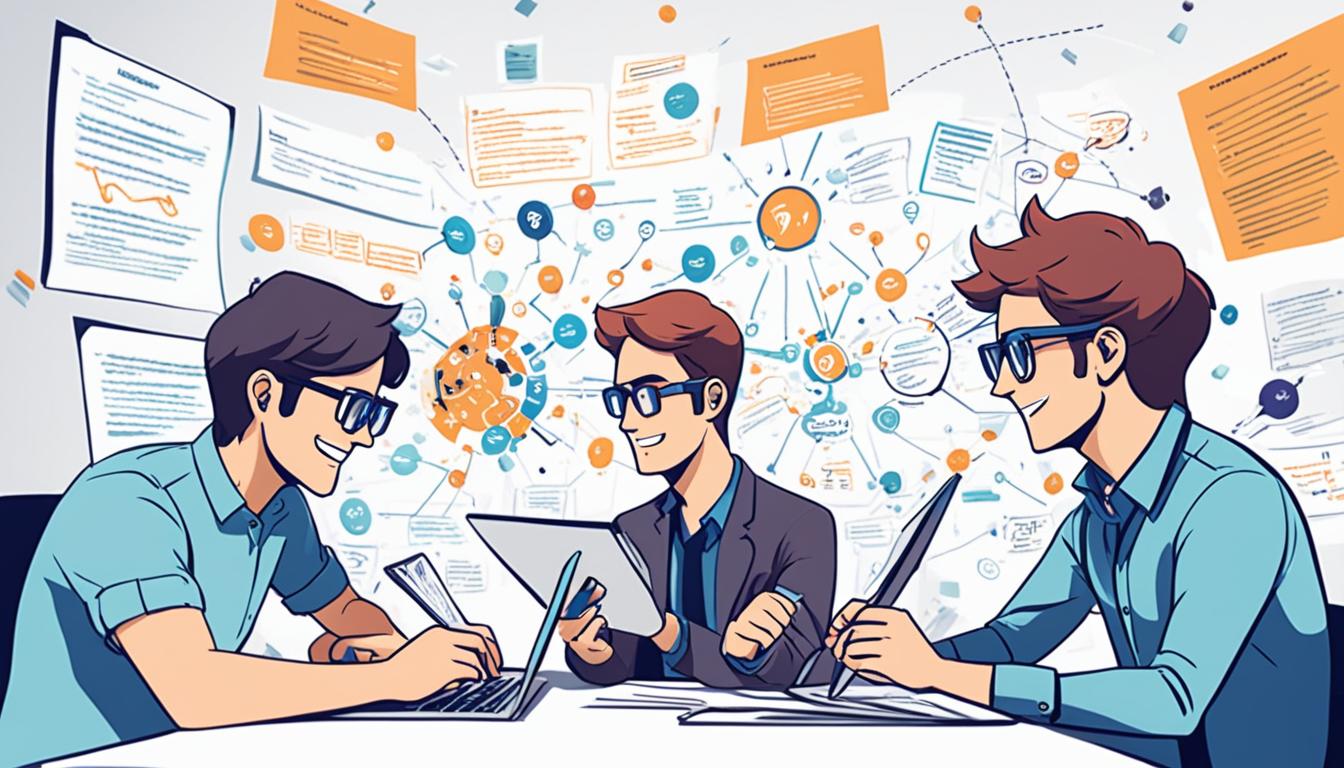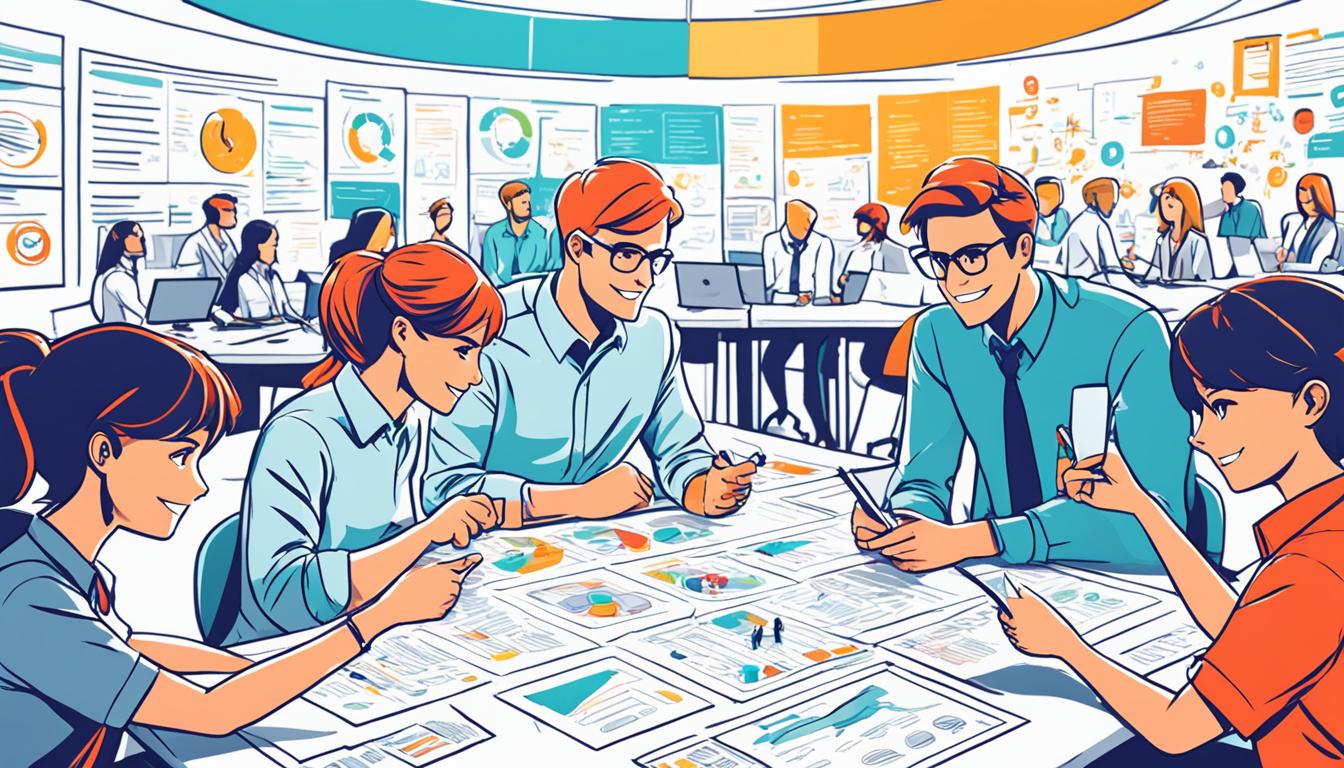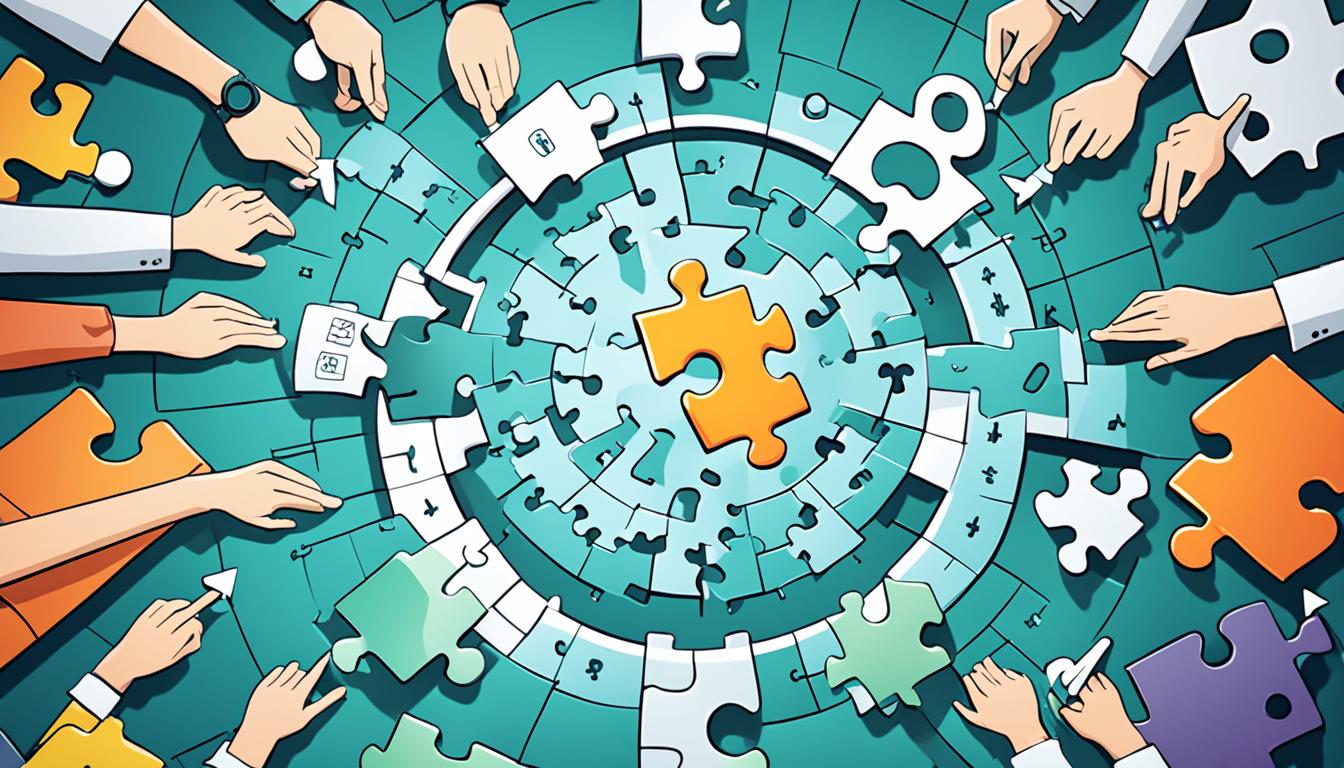
“Meeting Agenda Templates: Your Blueprint for Success””
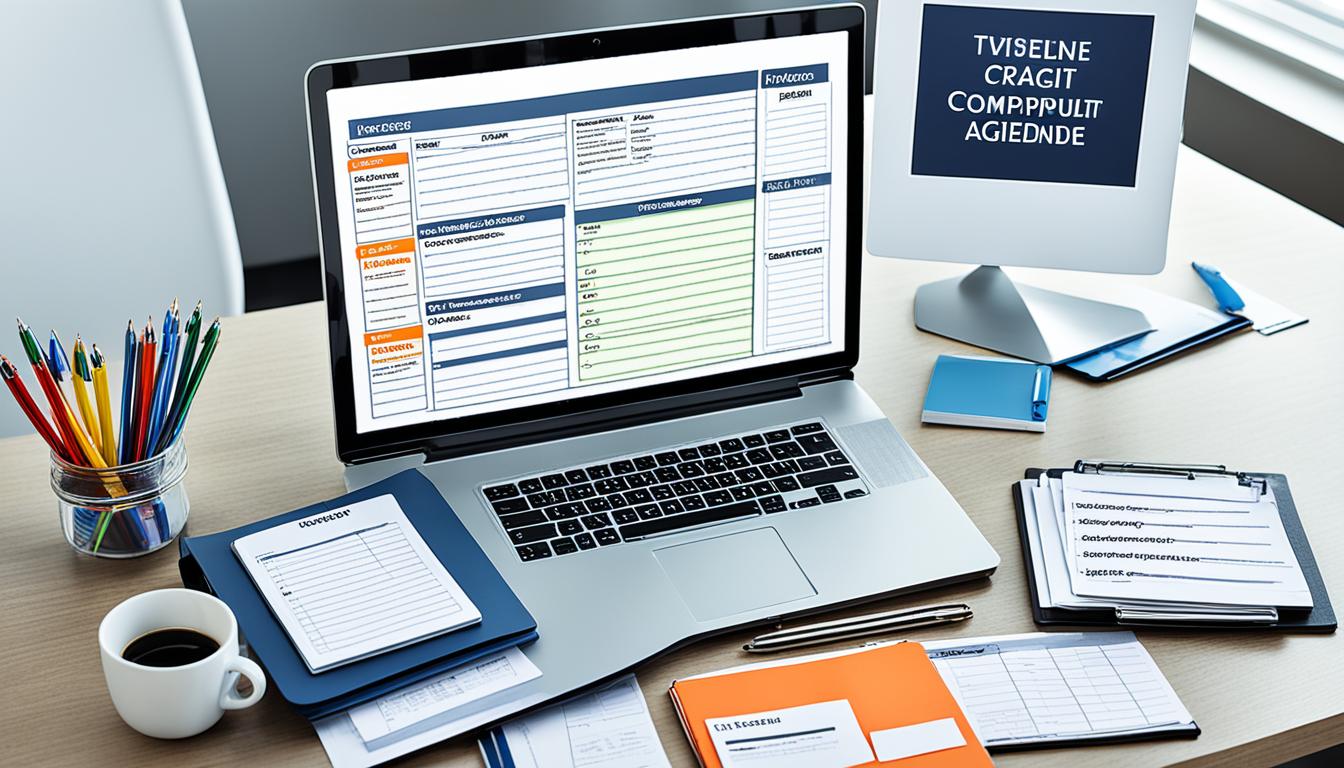
“In preparing for battle, I have always found that plans are useless, but planning is indispensable.” – Dwight D. Eisenhower
Effective meeting planning is the key to success in the world of business. Whether it’s a small team meeting or a large-scale conference, having a well-organized and structured agenda is crucial. It sets the tone for productive discussions, keeps participants engaged, and ensures that goals are met. But how do you create an agenda that works for everyone and maximizes meeting efficiency?
Introducing meeting agenda templates – your blueprint for success. These pre-designed templates provide a framework for creating effective meeting agendas. They help you outline the flow of the meeting, define objectives for each agenda item, and allocate time wisely. With the right agenda template, you can streamline the meeting planning process, improve productivity, and enhance overall meeting success.
Key Takeaways:
- Meeting agenda templates serve as blueprints for structuring discussions and keeping meetings on track.
- Creating a well-designed agenda template saves time, ensures consistency, and contributes to meeting success.
- Different types of meetings require specific agenda templates, such as team meetings or emergency meetings.
- Using a meeting agenda template offers benefits like streamlining meetings, increasing productivity, and standardizing the meeting process.
- Effective meeting planning involves clear communication, thorough preparation, and proper follow-up on action items.
The Purpose of a Meeting Agenda Template
A meeting agenda template serves as a blueprint for the meeting, outlining the phases and objectives of the discussion. It brings consistency to meeting planning and ensures that all necessary requirements are met. With the increase in the frequency of meetings, having a formal meeting agenda template is vital to save time for leaders and maintain consistency across teams.
By providing a clear structure, a meeting agenda template helps to align the efforts of all participants towards the meeting’s goals. It sets expectations for what will be covered and in what order, ensuring that everyone is on the same page. This structure helps to keep the meeting focused and prevents it from veering off-topic.
Additionally, a meeting agenda template ensures that all necessary items are addressed during the meeting. It helps to identify key discussion points, allocate appropriate time for each item, and prioritize important matters. This ensures that all relevant topics are covered and that the meeting is as productive as possible.
Not only does a meeting agenda template benefit meeting attendees, but it also saves time for leaders. Rather than starting from scratch for each meeting, a template provides a consistent foundation to work from. This streamlines the planning process, allowing leaders to focus their energy on other important tasks.
Furthermore, the use of a meeting agenda template across teams promotes consistency and uniformity in meeting management. It ensures that meetings are planned and conducted in a similar manner, regardless of who is leading or attending. This consistency creates a predictable structure that team members can rely on, leading to more efficient and effective meetings.
“Having a well-designed meeting agenda template can streamline the meeting planning process and contribute to meeting success.”
Overall, a meeting agenda template serves as a valuable tool for meeting planning and execution. It provides a clear structure, ensures all necessary items are addressed, saves time for leaders, and promotes consistency across teams. By utilizing a meeting agenda template, businesses can enhance their meeting effectiveness and drive better outcomes.
| Purpose of Meeting Agenda Template | Benefits |
|---|---|
| Outlines the phases and objectives of the meeting | Brings consistency to meeting planning |
| Helps to keep the meeting focused and on-topic | Ensures all necessary items are addressed |
| Saves time for leaders | Promotes consistency and uniformity in meeting management |
Creating a Meeting Agenda Template
When it comes to creating a meeting agenda template, there are several key basics that you should consider. By following these fundamentals, you can ensure that your meeting agenda is effective in guiding the discussions and achieving the desired outcomes.
Basics of Meeting Agenda Template
Start by including essential information such as the date, time, and location of the meeting. This allows participants to plan their schedules accordingly and ensures everyone is aware of when and where the meeting will take place.
Next, identify the participants and their respective roles. This enables you to assign specific responsibilities and ensures that everyone involved has a clear understanding of their contributions to the meeting.
State the overall objective of the meeting and each agenda item. Clearly defining the purpose of the meeting helps participants focus on the key topics and aligns their efforts towards achieving the desired outcomes.
Objectives of Agenda Items
Each agenda item should have clear objectives. These objectives outline what needs to be accomplished during the discussion and serve as a guide for the participants. They ensure that the conversation remains focused and productive.
Leaders of Agenda Items
Designate specific leaders for each agenda item. These leaders are responsible for facilitating the discussion, keeping the conversation on track, and ensuring that all relevant points are addressed. Having designated leaders helps maintain structure and accountability throughout the meeting.
Types of Agenda Items
Categorize each agenda item as information, discussion, or voting. This classification allows participants to understand the purpose of each item and provides clarity on the expected outcomes. It helps in organizing the meeting flow and ensures that all necessary discussions and decisions are made.
Documents for Agenda Items
Include relevant documents for each agenda item. These documents provide context, background information, and supporting materials that participants need to review before the meeting. By providing these documents in advance, you allow participants to come prepared and contribute effectively during the discussion.
To illustrate, here’s an example of how a section of a meeting agenda template could be structured:
| Agenda Item | Objective | Leader | Type | Documents |
|---|---|---|---|---|
| Welcome and Introductions | Set a positive tone for the meeting and introduce participants | Meeting Chair | Information | – |
| Project Update | Review progress and discuss any challenges | Project Manager | Discussion | Project Report |
| Budget Approval | Vote on the proposed budget for the upcoming quarter | Finance Director | Voting | Budget Proposal |
Creating a well-designed meeting agenda template sets the foundation for productive and successful meetings. It ensures that all participants are prepared, focused, and aligned towards achieving meeting objectives. Utilize these basics to create an effective agenda template that enhances your meeting processes.
Team Meeting Agenda Template
When it comes to team meetings, having a structured agenda is essential for productivity and collaboration. A team meeting agenda template provides a framework for regular team meetings, whether they are weekly staff meetings, one-on-one meetings, or brainstorming sessions. By using a team meeting agenda template, you can streamline the meeting process, set clear expectations, and ensure that all important topics are covered.
With a team meeting agenda template, you can allocate specific time slots for different agenda items, allowing for a more organized and efficient discussion. This helps to avoid wasting valuable time and ensures that all team members have an opportunity to contribute.
Here is an example of a team meeting agenda template:
| Time | Agenda Item | Objective | Leader |
|---|---|---|---|
| 9:00 AM | Opening Remarks | Set the tone for the meeting and review the agenda | Team Leader |
| 9:15 AM | Project Updates | Discuss progress, challenges, and next steps for ongoing projects | Project Manager |
| 9:45 AM | One-on-One Meetings | Provide an opportunity for individual discussions and feedback | Team Leader |
| 10:15 AM | Brainstorming Session | Generate ideas and solutions for a specific challenge | Facilitator |
| 10:45 AM | Wrap-up and Action Items | Summarize key takeaways and assign tasks for follow-up | Team Leader |
Using a team meeting agenda template ensures consistency in meeting structure and makes it easier for everyone involved to prepare and contribute effectively. It also serves as a reference point for future meetings, allowing you to track progress and revisit important discussions.
Remember, a well-structured team meeting agenda template is a valuable tool for promoting collaboration, driving productivity, and ensuring that your team meetings are productive and successful.
Emergency Meeting Agenda Template
In times of emergencies, having an emergency meeting agenda template can ensure that businesses respond effectively and take immediate actions. Common types of emergencies in business include natural disasters, cybersecurity breaches, and financial crises. The steps for conducting an emergency meeting include preparing for the meeting, conducting the meeting, and following up with post-meeting activities.
Types of Emergencies in Business
Emergencies can arise in various forms in a business setting. It is crucial to identify the types of emergencies that may occur to adequately prepare for them. Common types of emergencies in business include:
- Natural disasters such as floods, earthquakes, fires, or severe weather conditions
- Cybersecurity breaches, including data breaches, network outages, or malware attacks
- Financial crises, such as sudden economic downturns, bankruptcy filings, or loss of major clients
Steps for Conducting an Emergency Meeting
Conducting an emergency meeting requires careful planning and execution to address the urgent situation effectively. The following steps can guide you in conducting a successful emergency meeting:
- Preparation: Determine the purpose and objectives of the emergency meeting. Identify key stakeholders and participants who need to be informed and involved. Prepare an agenda that outlines the topics to be discussed and the actions to be taken.
- Conduction: Start the emergency meeting by emphasizing the severity and urgency of the situation. Present the facts, share updates, and encourage open discussion among participants. Assign responsibilities and delegate tasks to address the emergency effectively.
- Post-Meeting Follow-Up: After the emergency meeting, it is crucial to follow up on the decisions made and actions assigned. Evaluate the effectiveness of the emergency response and identify any areas that require further attention. Communicate with relevant stakeholders to ensure proper implementation of the agreed-upon actions.
Post-Meeting Follow-Up
Post-meeting follow-up is essential to ensure that the actions discussed in the emergency meeting are implemented effectively. It involves monitoring progress, addressing any obstacles or challenges, and evaluating the overall response to the emergency situation. Effective post-meeting follow-up helps to minimize the impact of the emergency and ensure a smooth recovery process.
| Benefits of an Emergency Meeting Agenda Template | |
|---|---|
| Ensures prompt response to emergencies | |
| Provides a clear structure for discussions | |
| Helps assign responsibilities and delegate tasks | |
| Facilitates effective communication during critical situations | |
| Ensures documentation of decisions and actions taken |
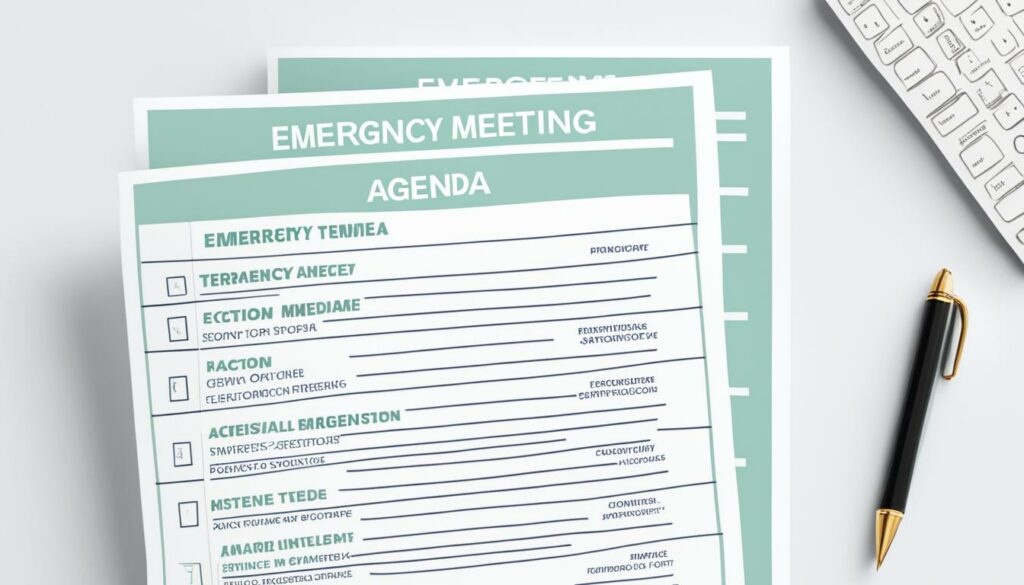
Benefits of Using a Meeting Agenda Template
Using a meeting agenda template offers several benefits. It streamlines the meeting process, ensuring that meetings are well-organized and efficient. It helps increase productivity by keeping meetings focused and on track. By providing relevant information in advance, it improves meeting preparation and allows participants to come prepared with the necessary materials and knowledge.
One of the key advantages of using a meeting agenda template is that it helps standardize the meeting process across teams. When all teams follow a consistent format and structure, it becomes easier for participants to understand and follow the agenda. This promotes better collaboration, communication, and decision-making.
Moreover, a meeting agenda template ensures that all essential elements are included in each meeting, such as introductions, review of previous meeting minutes, updates, discussion topics, and action items. This consistency and standardization help maintain focus and prevent meetings from veering off-topic or becoming unproductive.
| Benefits of Using a Meeting Agenda Template | Description |
|---|---|
| Streamline Meetings | A meeting agenda template helps streamline meetings, ensuring they are well-organized and efficient. |
| Increase Productivity | By keeping meetings focused and on track, a meeting agenda template increases productivity. |
| Improve Meeting Preparation | The use of a meeting agenda template improves meeting preparation by providing relevant information in advance. |
| Standardize Meeting Process | Using a meeting agenda template ensures that teams follow a consistent format and structure, standardizing the meeting process. |
When all team members are familiar with the meeting agenda template, they can better prepare for the topics at hand, contribute meaningfully to discussions, and take appropriate action on assigned tasks. This ultimately leads to more efficient and productive meetings.
“Using a meeting agenda template is like having a roadmap for success in meetings – it keeps everyone on the same page and guides the discussion towards achieving the desired outcomes.”
If organizations want to streamline their meeting process, increase productivity, improve meeting preparation, and standardize the meeting process, then incorporating a meeting agenda template is essential.
Tips for Effective Meeting Planning
Effective meeting planning is crucial for successful meetings. By implementing a few key strategies, you can ensure that your meetings are well-prepared, organized, and productive. Follow these tips to enhance your meeting planning process and maximize the outcomes of your meetings.
1. Set Clear Objectives
Before planning any meeting, it’s important to determine clear objectives. Clearly define what you hope to achieve during the meeting to keep the discussion focused and on track. This will help you create an agenda that covers all necessary topics and ensures that all participants are aligned with the meeting’s purpose.
2. Send Out Meeting Notices in Advance
Communicate with your meeting participants in advance by sending out meeting notices. Provide them with details such as the meeting date, time, duration, and agenda. This gives participants enough time to prepare, review any relevant materials, and come ready with their contributions and questions.
3. Create an Agenda with Realistic Time Allocations
A well-structured agenda is essential for effective meeting planning. Break down the meeting into different agenda items and allocate realistic amounts of time to each item. This ensures that discussions don’t overrun and that all topics are adequately covered. Be mindful of the participants’ availability and set appropriate time limits to maintain a productive pace throughout the meeting.
Here’s an example of how you can structure your agenda:
| Agenda Item | Time Allocation |
|---|---|
| Introduction and Welcome | 5 minutes |
| Review of Previous Meeting Minutes | 10 minutes |
| Project Updates | 20 minutes |
| Discussion of Key Challenges | 30 minutes |
| Action Items and Next Steps | 15 minutes |
| Wrap-up and Conclusion | 5 minutes |
4. Document the Meeting Properly
Take thorough meeting notes to document key discussion points, decisions, and action items. This ensures that there is a record of the meeting outcomes and provides a reference for future follow-ups. Distribute the meeting minutes to all participants shortly after the meeting to keep everyone informed and accountable.
“Effective meeting planning involves thorough preparation, clear communication, time management, and proper follow-up. Setting clear objectives, sending out meeting notices in advance, creating an agenda with realistic time allocations, and documenting the meeting properly are essential for successful meetings.” – John Smith, CEO
By incorporating these tips into your meeting planning process, you can foster more productive and efficient meetings. Remember to adjust your approach and strategies based on the specific needs of your team and the nature of the meeting. Effective meeting planning is key to driving positive outcomes and ensuring that your meetings are valuable and actionable.
Using Technology for Meeting Management
Technology can revolutionize meeting management, providing efficient solutions for organizing and optimizing your meetings. With the help of advanced meeting management technology, you can streamline the entire process, from agenda creation to meeting documentation and collaboration. Take advantage of Meeting Agenda Software, Meeting Notes Software, and Meeting Recording Software to enhance your meeting management practices and drive productivity.
Meeting Agenda Software
Using Meeting Agenda Software can automate and simplify the creation and distribution of meeting agendas. This software allows you to customize templates, add agenda items, assign timeframes, and invite participants. By creating consistent and comprehensive agendas, you ensure that all important topics are covered, and everyone is well-prepared. This efficient tool saves time and keeps meetings focused and on track.
Meeting Notes Software
Meeting Notes Software offers a digital platform for taking and sharing meeting minutes. During meetings, this software allows you to document key discussion points, decisions, and action items in real-time. With the ability to collaborate and share notes with participants, team members can stay aligned and accountable. Meeting Notes Software eliminates the need for manual note-taking and ensures accurate and accessible meeting records.
Meeting Recording Software
Meeting Recording Software enables you to record and transcribe meetings, providing a valuable resource for future reference. By capturing audio, video, and screen-sharing, you can review important discussions, clarify details, and access the meeting content at any time. This software eliminates the risk of missing out on crucial information and helps maintain a comprehensive meeting archive.
Using technology for meeting management offers numerous benefits, including:
- Enhanced organization and structure
- Improved accessibility to meeting agendas and notes
- Increased collaboration and engagement
- Time-efficient preparation and follow-up
By leveraging Meeting Agenda Software, Meeting Notes Software, and Meeting Recording Software, you can optimize your meeting management practices and ensure productive and impactful meetings.
Now, let’s take a deeper look at the impact of meeting management technology with the help of a visual representation:
| Benefits of Meeting Management Technology | Meeting Agenda Software | Meeting Notes Software | Meeting Recording Software |
|---|---|---|---|
| Enhanced organization and efficiency | Automated agenda creation | Real-time note-taking | Record and transcribe meetings |
| Streamlined meeting planning | Customizable agenda templates | Shareable meeting minutes | Accessible meeting recordings |
| Improved collaboration and engagement | Invite participants and assign responsibilities | Collaborate and share notes | Review important discussions |
| Time-efficient preparation and follow-up | Saves time in agenda creation | Eliminates manual note-taking | Easy reference for future meetings |
Conclusion
Meeting agenda templates are indispensable tools for achieving meeting success. They serve as blueprints for efficient and productive meetings, ensuring that discussions stay focused and objectives are met. By following the steps for effective meeting planning and harnessing the power of technology for meeting management, businesses can optimize their meetings and enhance overall productivity.
Using a meeting agenda template is a strategic approach to meeting preparation that sets the stage for success. It provides structure and clarity, enabling participants to come prepared and contribute meaningfully. With a well-designed agenda, you can streamline the meeting process, keep discussions on track, and maximize the use of everyone’s time.
Efficient meetings are essential for driving business growth and achieving goals. A meeting agenda template helps you achieve this by clarifying objectives, assigning responsibilities, and creating a roadmap for discussions. By utilizing agenda templates, businesses can create a culture of efficiency and effectiveness, enabling teams to collaborate and make informed decisions. So, embrace the power of meeting agenda templates and unlock the full potential of your meetings.
















